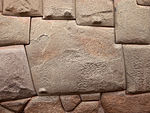Oca (structure)
Brazilian indigenous housing

Oca is the name given to the typical Brazilian indigenous housing. The term comes from the Tupi-Guarani language family.
They are large buildings, serving as collective housing for several families,[1] and may reach 40 m (130 ft) in length.[2] They are built through joint effort over one week, with a wooden structure and bamboo and straw cover or palm leaves. They can last up to 15 years. They have no internal divisions or windows, only a few doors.
See also
- Maloca
- Vernacular architecture
References and notes
- General
- COP8/MOP3, 16 March 2003. Amanhã, cerimônia ao pôr do sol inaugura ocas Xavante, by Marina Koçouski.
- Arte Indígena
- Citations
- v
- t
- e
Hut dwelling designs and semi-permanent human shelters
- Bahay kubo (Nipa hut)
- Barabara
- Beehive house
- Bothy
- Bunong
- Burdei
- Bure
- Cleit
- Clochán (beehive hut)
- Crotto
- Dugout
- Earth lodge
- Funco
- Girna
- Goahti
- Hogan
- Humpy
- Icelandic turf house
- Igloo
- Jacal
- Kapar
- Log cabin
- Maloca
- Menstruation
- Mitato
- Musgum mud huts
- Oca
- Orri
- Palloza
- Pit-house
- Qargi
- Qarmaq
- Quiggly hole
- Quinzhee
- Rondavel
- Roundhouse
- Ruka
- Sassi di Matera
- Shieling
- Sod house
- Sukkah
- Tongkonan
- Trullo
- Tukul
- Wigwam, wickiup and wetu
- Zemlyanka

- Beach fale
- Cabana
- Chickee
- Gazebo
- Palapa
- Pergola
- Ramada
- Toguna
 Category
Category Portal
Portal
 | This article about a Brazilian building or structure is a stub. You can help Wikipedia by expanding it. |
- v
- t
- e













